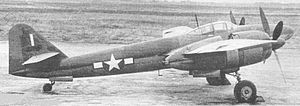TheMitsubishi Ki-83(キ83) was a Japanese experimental, long-rangeheavy fighterdesigned near the end of World War II that did not reach production status.
| Ki-83 | |
|---|---|

| |
| A Ki-83 in American markings after the war. | |
| Role | Long rangeheavy fighter |
| Manufacturer | Mitsubishi |
| First flight | 18 November 1944 |
| Status | Prototype |
| Number built | 4 |
Design and development
editThe Mitsubishi Ki-83 was designed as a long-range heavy fighter and built by a team, led byTomio Kubo- designer of the highly successfulMitsubishi Ki-46.The design was a response to a 1943 specification for a new heavy fighter with great range. The first of fourprototypesflew on 18 November 1944.[1]The machines displayed remarkable maneuverability for aircraft of their size, being able to execute a 671 m (2,200 ft) diameter loop in just 31 seconds at a speed of over 644 km/h (400 mph).[2]The Ki-83 carried a powerful armament of two 30 mm (1.18 in) and two 20 mm cannon in its nose.[3]
Despite the bomb-ravaged Japanese manufacturing sector, plans for the Ki-83 to enter production were underway when Japan surrendered on 15 August 1945.
Both the existence and performance of the Ki-83 were little known during the War, even in Japan. It was completely unknown inAlliedmilitary aviation circles – as demonstrated by the fact that the Ki-83 had not been given areporting name.Most early photographs of the type were taken during the post-war occupation of Japan, when the four prototypes were seized by theUnited States Army Air Forcesand repainted with USAAF insignia. When they were evaluated by U.S.aeronautical engineersand other experts, a Ki-83, using high-octanefuel, reached a speed of 762 km/h (473 mph) at an altitude of 7,000 metres (23,000 ft).[1][2][4][5]
Variants
edit- Ki-83experimental long-rangeheavy fighter,four prototypes built.
- Ki-95projected reconnaissance version, none built.[6]
- Ki-103projected development, none built.[6]
Specifications (Ki-83)
editData fromJapanese Aircraft of the Pacific War[7]
General characteristics
- Crew:2
- Length:12.5 m (41 ft 0 in)
- Wingspan:15.5 m (50 ft 10 in)
- Height:4.6 m (15 ft 1 in)
- Wing area:33.5 m2(361 sq ft)
- Empty weight:5,980 kg (13,184 lb)
- Gross weight:8,795 kg (19,390 lb)
- Max takeoff weight:9,430 kg (20,790 lb)
- Powerplant:2 ×Mitsubishi Ha-43Ru (Ha211) 18-cylinder air-cooledradial piston engines,1,600 kW (2,200 hp) each for take-off
- 1,540 kW (2,070 hp) at 1,000 m (3,300 ft)
- 1,440 kW (1,930 hp) at 5,000 m (16,000 ft) and 6,400 m (21,000 ft)
- 1,280 kW (1,720 hp) at 9,500 m (31,200 ft)
- Propellers:4-bladed constant-speed propellers
Performance
- Maximum speed:704.5 km/h (437.8 mph, 380.4 kn) at 9,000 m (30,000 ft)
- 655 km/h (407 mph; 354 kn) at 5,000 m (16,000 ft)
- Cruise speed:450 km/h (280 mph, 240 kn) at 4,000 m (13,000 ft)
- Range:1,953 km (1,214 mi, 1,055 nmi)
- Ferry range:3,500 km (2,200 mi, 1,900 nmi)
- Service ceiling:12,660 m (41,540 ft)
- Time to altitude:10,000 m (33,000 ft) in 10 minutes
- Wing loading:263 kg/m2(54 lb/sq ft)
- Power/mass:0.35 kW/kg (0.21 hp/lb)
Armament
- Guns:2× 30 mmHo-155 cannon(60 rpg ) and 2× 20 mmHo-5 cannon(160 rpg ) cannon mounted in the fuselage nose
See also
edit- de Havilland Hornet
- Dornier Do 335
- Focke-Wulf Ta 154
- Grumman F7F Tigercat
- Junkers Ju 388
- Kawasaki Ki-96
- Lockheed XP-58 Chain Lightning
- McDonnell XP-67
- Savoia-Marchetti SM.92
- Messerschmitt Me 410
- Nakajima J5N
- North American F-82 Twin Mustang
- Northrop P-61 Black Widow
- Northrop F-15 Reporter
- Rikugun Ki-93
References
edit- ^abFrancillon 1979,p. 192.
- ^abGreen 1961,p. 58.
- ^Pearce, William (30 September 2013)."Mitsubishi Ki-83 Heavy Fighter".oldmachinepress.Retrieved2 June2016.
- ^Green & Swanborough 1976,pp. 53, 56.
- ^FAOW 1976,p. 50.
- ^abFrancillon 1979,p. 193.
- ^Francillon 1979,p. 194.
Bibliography
edit- Francillon, René J. (1979).Japanese aircraft of the Pacific War.London: Putnam.ISBN0-370-30251-6.OCLC6124909.(new edition 1987 by Putnam Aeronautical Books,ISBN0-85177-801-1.)
- Green, William (1961).War Planes of the Second World War, Volume Three: Fighters.Macdonald & Co.ISBN0-356-01447-9.OCLC655407936.
- Green, William; Swanborough, Gordon (1976).JWW2 Aircraft Fact Files: Japanese Army Fighters, Part 1.London: Macdonald and Jane's.ISBN0-356-08224-5.OCLC820486093.
- Army Experimental Fighters (1).Famous Airplanes of the World Series 1. Tokyo: Bunrin-Do. August 1976.